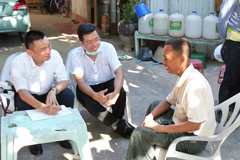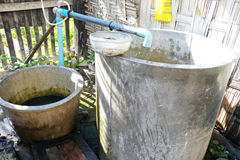Monitoring the Baseline Survey to Analyze the Effectiveness of a Water Supply Project in Myanmar
2018.07.19
In January 2018, the JICA Research Institute (JICA-RI) launched a new project entitled “An Empirical Study on the Urban Water Supply Project in Myanmar.” In conjunction with the start of the baseline survey in May 2018, Hiroaki Asaoka, senior research fellow at JICA-RI, Yasuharu Shimamura, an associate professor at Kobe University, and Takuji Tsusaka from the Asian Institute of Technology and the International Crops Research Institute for the Semi-Arid Tropics (ICRISAT), who are involved in this research project, visited the site to carry out monitoring.
This research project will take advantage of JICA-RI’s strengths to push forward with an empirical study on the impact of infrastructure projects. It will focus on the Project for Improvement of Water Supply System in Mandalay City, a grant aid project by JICA, to demonstrate the specific effects of water supply system development. In this project, new piped-water supply facilities will be installed in Pyi Gyi Tagon Township, located in the southern part of Mandalay city, the second-largest city in Myanmar. At present, most of the local residents have shallow wells in each house, and almost all the water used in daily life is pumped up from those wells. For drinking water, the residents mainly purchase water in 20-liter bottles. Typical households dig wells without any authorization by the local government, so the government is not aware of the exact location of wells or how much water is used. The groundwater level has fallen in this area in recent years, requiring residents to dig their wells even deeper, making it more difficult to obtain the water. Unbridled use of groundwater provides residents with short-term benefits, but this practice increases the risk of poorer access to water in the long term.

Hiroaki Asaoka, senior research fellow at JICA-RI (left), is interviewing locals. Behind them are 20-liter bottles of water purchased for drinking purpose

Shallow wells and water tanks are common sight in the area surveyed
This project is installing water supply facilities that consist of two production wells, a distribution reservoir, a sewage pumping station, water distribution pipes, a chlorination facility, and water supply pipes. Water supply meters will also be installed at each house. However, the connection to the piped-water supply system does not necessarily mean that residents will use the water only from the piped-water supply system. It is assumed that the system will compete with bottled water for drinking purposes, and that households will use both the piped-water system and existing wells for other daily-use water. In order to verify the effects of this water supply project, the changes in water usage patterns and the well-being of residents will be analyzed. To do this, a comparison area adjacent to the project area was determined and the houses of 1,350 families will be visited for the household survey. The survey will obtain detailed information about water sources, water usage volume, expenses, level of satisfaction with water quality, and the willingness to pay for water supply, as well as the household member information, their medical condition, their level of satisfaction with their life, their relationship with the community, and so on.
The research consists of the baseline survey, the mid-line survey, the end-line survey, and monthly record keeping on water usage. The baseline survey began in May 2018, and the end-line surveys are scheduled for the same period one year later. In order to monitor the baseline survey, the research team members visited the area from May 6 to 25, 2018. They conducted this field trip to monitor the training of surveyors and to provide the guidance on improving and finalizing their questionnaires using tablets as the survey tools. Initially, the household surveys took a long time. Providing guidance and advice to the surveyors enabled them to shorten the time and improve the quality of the survey. This research will analyze the changes over one year with the data collected until the end-line survey in order to verify the effects of this water supply project.

事業事前評価表(地球規模課題対応国際科学技術協力(SATREPS)).国際協力機構 地球環境部 . 防災第一チーム. 1.案件名.国 名: フィリピン共和国.

事業事前評価表(地球規模課題対応国際科学技術協力(SATREPS)).国際協力機構 地球環境部 . 防災第一チーム. 1.案件名.国 名: フィリピン共和国.

事業事前評価表(地球規模課題対応国際科学技術協力(SATREPS)).国際協力機構 地球環境部 . 防災第一チーム. 1.案件名.国 名: フィリピン共和国.

事業事前評価表(地球規模課題対応国際科学技術協力(SATREPS)).国際協力機構 地球環境部 . 防災第一チーム. 1.案件名.国 名: フィリピン共和国.

事業事前評価表(地球規模課題対応国際科学技術協力(SATREPS)).国際協力機構 地球環境部 . 防災第一チーム. 1.案件名.国 名: フィリピン共和国.
scroll